#european common frog
Text
Amphibiuary 2024 Day 19: Underrated

While frogs are certainly not underrated at all, there's definitely a wide gulf between popular species and the ones seen as either bland or 'common' (unfortunately very few frogs are 'common' anymore, even the ones with it in the name!!). The European Common Frog is seen as a bit of boring one, but whenever we get one in the garden it feels like a special gift just for me uwu
#amphibiuary2024#underrated#european common frog#frogs#artists on tumblr#my art#art#traditional art#traditional illustration#illustration#promarkers#original work#cartoon illustration#cartoon#cute
83 notes
·
View notes
Text

European common frogs (Rana temporaria)
By: Walter Rohdich
From: Living Amphibians of the World
1966
#european common frog#frog#amphibian#1966#1960s#Walter Rohdich#Living Amphibians of the World (1966)
57 notes
·
View notes
Note
Hello I would like to request your favourite little freak(amphibian) for day 1432
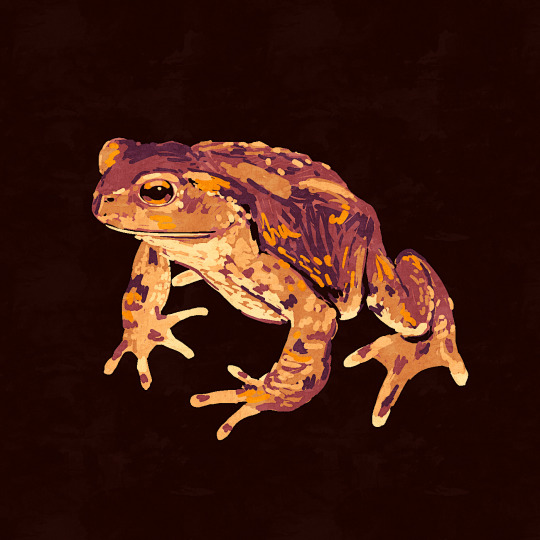
day 1432
#amphibian#frog#toad#european common toad#i had to look up what 1432 means but i think its cute#i interpret this as just my favorite amphibian which is the common toad#i think you can tell from my art that its one of the amphibians i instinctually go for when i have no specific species to draw#i know its a boring answer but its a good frog. plain and simple#and its the one i've actually interracted with the most irl :)#and more specifically we had a toad that lived in the drain in the cellar in a previous house#its where we had all the laundry stuff. so we called him laundry frog. he is like the patron saint of laundry. to me#laundry frog specifically is my favorite little freak#laundry frog#oops i think i forgot to save the alt text#it should be fixed now but i have no idea how that works in relobgs
600 notes
·
View notes
Text

Reptiles, Amphibia, Fishes and Lower Chordata. Written by Richard Lydekker and others. Illustration by J. Green. Published in 1912.
Internet Archive
147 notes
·
View notes
Text
Bufo bufo




The common toad. Even if they are considered ordinary, I find them beyond precious and worthy of love :)
#toad#frog#amphibian#phrog#frog photo#frog photography#toad photo#phrog photo#herpblr#bufo bufo#common toad#european common toad#bufo#i love toads#lil guy#goblincore#little guy#just a lil guy vibing tbh
47 notes
·
View notes
Text
Have you heard about mole genders?

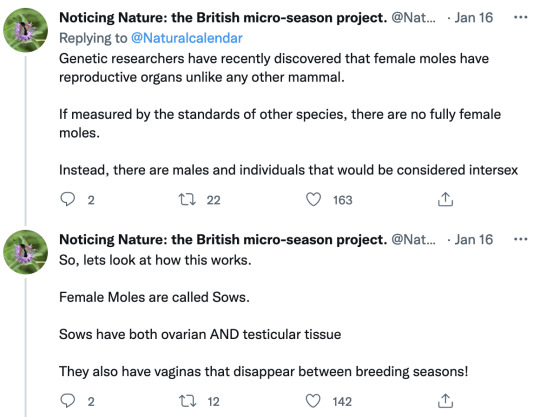




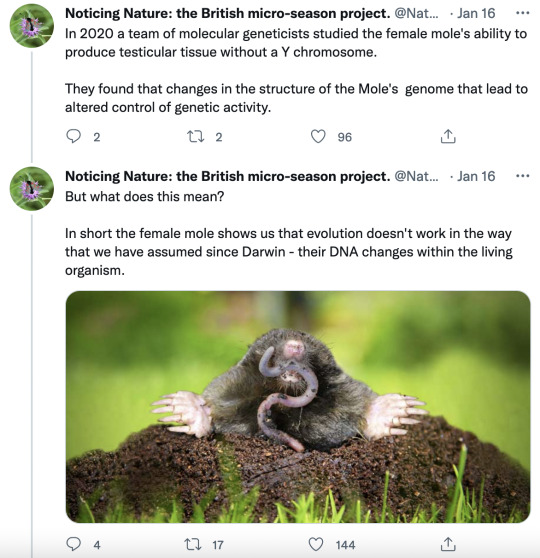
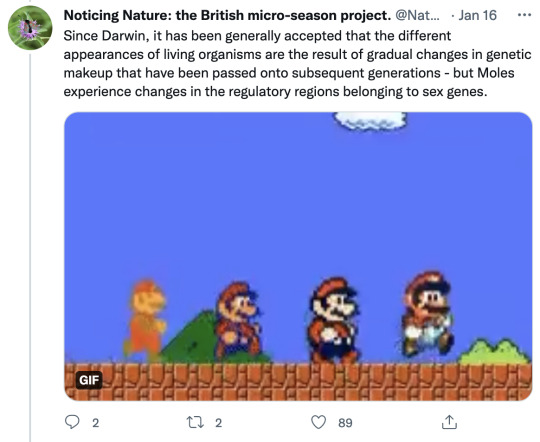
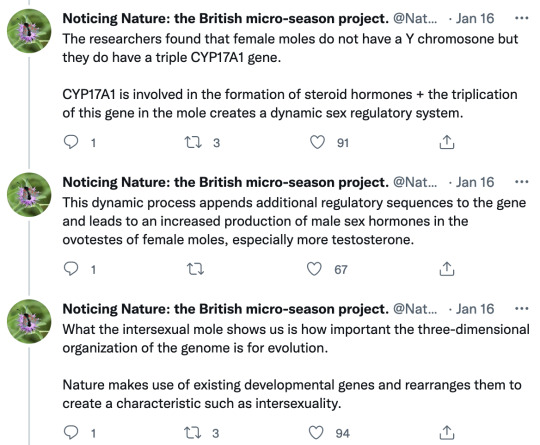

I’ve heard of this concept in sci-fi, but thought it was absolutely made up. I know some fish and frogs can change genders, but not in cycles like this. Wild. If I slapped this down in some alien world without explanation, I’d laugh in my own face. But no, real biology IS that bizarre.
Image descriptions:
A series of tweets from @NaturalCalendar that say:
Hello lovely Nature Noticers. It is time for today's thread! Follow me, and we'll delve deep into the subterranean and subversive world of Talpa europaea, the common European mole. We'll begin with a bombshell - there are no female moles.
Genetic researchers have recently discovered that female moles have reproductive organs unlike any other mammal. If measured by the standards of other species, there are no fully female moles. Instead, there are males and individuals that would be considered intersex.
So, lets look at how this works. Female Moles are called Sows. Sows have both ovarian AND testicular tissue They also have vaginas that disappear between breeding seasons!
Most of the year, female moles look and behave like males. They have masculinised genitals, with no external vagina + an enlarged clitoris. When this point in the year arrives, mating season begins. At this point the Sow's testosterone levels drop + they develop a vagina.
As is typical for mammals, Sows are equipped with two X chromosomes and Boars with an X and a Y chromosome. Unlike any other mammals Sows simultaneously develop functional ovarian and testicular tissues united in one organ, the 'ovotestis'. This is unique to Moles.
This testicular tissue does not produce sperm. It does however, produce large amounts of the sex hormone testosterone, meaning that Sows have similar testosterone levels to the Boars -except during mating season.
Scientists have hypothesized that these high levels of testosterone provide an adaptive advantage for the mole's underground life - providing added muscle mass for Sows who need to dig burrows and fight for resources for their offspring.
This is a dynamic process - the ovarian tissue that makes eggs and gets larger during breeding, then regresses. Outside of breeding season the testicular tissue, expands until it’s larger than the ovarian end - flooding the Sow's system with testosterone.
This explains why female moles have male-like genitalia... But it doesn't explain how patch of testicular tissue forms in female moles even though they do not have a Y chromosome. Up until recently the Y chromosome was thought to be fundamental to male sex determination.
In 2020 a team of molecular geneticists studied the female mole's ability to produce testicular tissue without a Y chromosome. They found that changes in the structure of the Mole's genome that lead to altered control of genetic activity.
But what does this mean? In short the female mole shows us that evolution doesn't work in the way that we have assumed since Darwin - their DNA changes within the living organism.
Since Darwin, it has been generally accepted that the different appearances of living organisms are the result of gradual changes in genetic makeup that have been passed onto subsequent generations - but Moles experience changes in the regulatory regions belonging to sex genes.
The researchers found that female moles do not have a Y chromosone but they do have a triple CYP17A1 gene. CYP17A1 is involved in the formation of steroid hormones + the triplication of this gene in the mole creates a dynamic sex regulatory system.
This dynamic process appends additional regulatory sequences to the gene and leads to an increased production of male sex hormones in the ovotestes of female moles, especially more testosterone.
What the intersexual mole shows us is how important the three-dimensional organization of the genome is for evolution. Nature makes use of existing developmental genes and rearranges them to create a characteristic such as intersexuality.
We see in the mole that evolution is not a linear process, arranged around the principle of Euclidian geometry. It is rather a topological process - a structure cast in rubber that is responsive and adaptive to the environment.
The mole also reminds us of the complexity of sexual development. The shifting sexual characteristics of the mole shows how the process of sexual development can, and does result in a wide range of natural variations.
#biology#gender#moles#fun animal facts#intersex#truth is stranger than fiction#yes I’ve read The Left Hand of Darkness#I’ve seen this idea elsewhere too#I had no idea it was based on something so exact#bonkers man#trans#mole genders
38K notes
·
View notes
Text
This Wet Beast Wednesday I'm going to talk about gars. This needs some clarification because there are a lot of different fish called gar, garfish, or garpike. I'm referring to fish of the family Lepisostidae, the only surviving members of the ancient clade Ginglimodi, which I mostly brought up because Ginglimodi is a funny name.
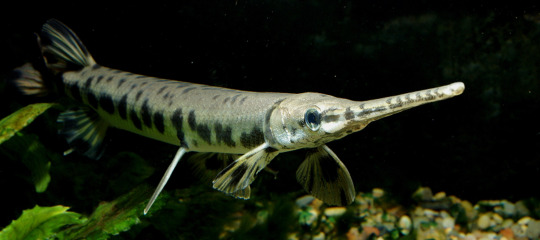
(image: a longnose gar)
Gars are predatory fish found exclusively in North and Central America, though they have been introduced outside of their native range. Their ancestors evolved in Triassic period and once occupied most of North America and large portions of Europe back when the continents were still connected. They are freshwater fish, though a few species will go into brackish or even marine waters temporarily. The name "gar" is though to come from the old english word for "spear", which is appropriate as gar are very elongated fish and often have pointy snouts. Many other groups of elongated fish are also given the common name of gar or garfish for this reason. Their long snouts are filled with sharp teeth which are used to crush through shells and flesh. Gars are opportunistic predators who feed largely on crustaceans, frogs, and fish and will eat carrion if they find it. The long snouts are also used to dig through sediment in search of prey They move slowly through the water, but are capable of short bursts of speed to catch prey. Most species are apex predators with no natural predators as adults.
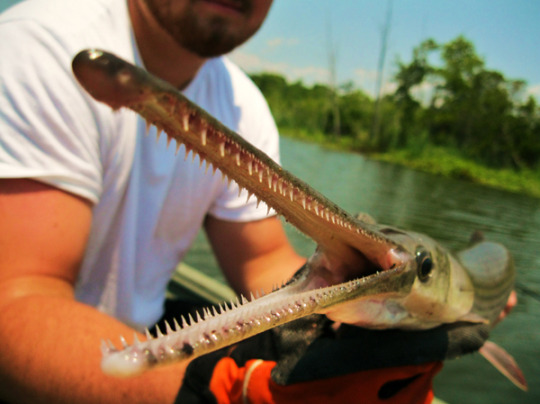
(image: a longnose gar with mouth open, displaying the teeth)
The body of a gar is covered with thick, diamond-shaped scales. Their scales are an ancient variety known as ganoid scales which are notable for their shape and composition. Where most bony fish scales have layers of a spongy, bony substance called cosmene, ganoid scales instead have an enamel-like substance called dentine, which is also a component in teeth. The scales are also covered in a rigid, glassy substance called ganoine where other scales use enameloid. Ganoid scales also don't overlap, instead laying next to each other in a manner that provided protection while still allowing flexibility. The result is a suit of armor that makes gar very durable. Because of how durable the scales are, they habe been used by humans for many purposes. Multiple Native American groups would use scales as arrowheads, there are reports of native Caribbean peoples wearing breastplates made of gar skin, and Europeans colonists would layer their plow heads with the scales to protect the,. There is currently a market for jewelry made of the scales.
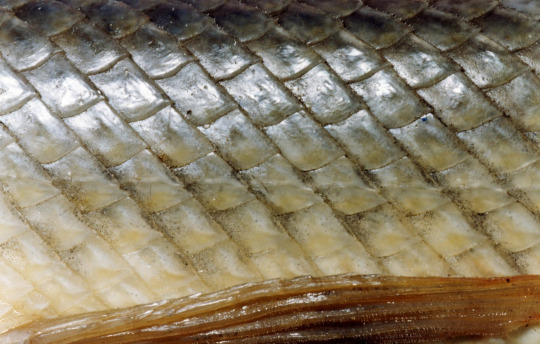
(image: a close-up of ganoid scales)

(image: an arrowhead made of a gar scale)
Gar typically lay their eggs in early spring, with the female coating vegetation with thousands of sticky eggs. The eggs are toxic to humans, capable of causing sickness when ingested. Because of this, they are unsuitable for caviar. Scientists initially thought that the toxin was an adaptation to prevent predation, but natural predators of the eggs like channel catfish and bluegill are immune. Crayfish are affected by the eggs, though it's not clear if the poison is an adaptation targeting them or not.

(image: a shortnose gar)
The swim bladder of gar is highly vascularized, allowing them to act as lungs. Most gar will surface occasionally to take a gulp of air. While they are capable of surviving on their gills alone in good-quality water, air gulping allows gar to thrive in low-oxygen water where their prey will be sluggish from oxygen deprivation. Most species live around 20 years, but the alligator gar can live upwards of 70 years.
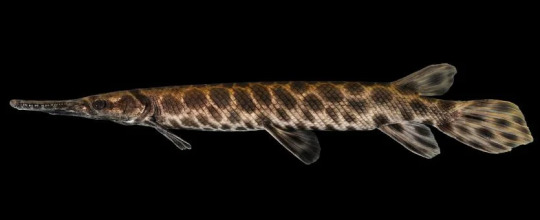
(image: a spotted gar)
There are seven living species of Gar: the Cuban gar, tropical gar, spotted gar, longnose gar, shortnose gar, Florida gar, and alligator gar. The shortenose gar is the smalles species, reaching an average length of 62.5 cm (24.6 in) while the alligator gar is the largest species and one of the largest of all American freshwater fish at an average length of 1.8 m (6 ft) in length. The largest alligator gar on record measured in 2.57 m (8 ft 5 in) and 148 kg (327 lbs). Alligator gar were long considered a nuisance species by fishermen as they preyed on sportfish and as a result, they were frequently killed. This resulted in population losses and the fish being extirpated from many states it was once native to. Now multiple states have laws and regulations protecting them and the population is starting to see a resurgence. Alligator gar and now a popular sportfish and have been introduced to places outside of their native range, becoming an invasive species in many areas including China.

(image: two fishermen with an alligator gar)
Gar meat is edible and is described as having a very unique taste compared to other fish meat. They are not commonly eaten in modern times, but some people consider them a delicacy. Gar meat is known to carry environmental toxins like pollutants and heavy metals, which can make eating them risky. Gar are mostly fished for their scales or for sport. Only the Cuban car is endangered (and critically so) while other species may be locally endangered, but as a whole are not threatened. Gar are used as aquarium fish due to their unique appearance, though they need large tanks due to their size.
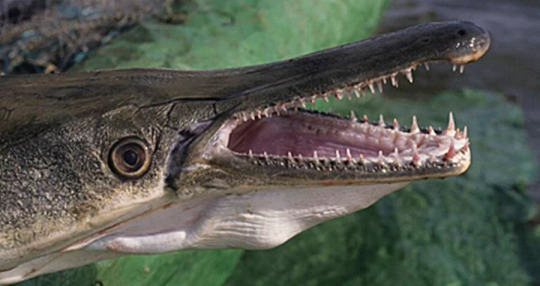
(image: a close-up of an alligator gar's head)
#wet beast wednesday#aquatic biology#fishblr#fish#ecology#zoology#animal facts#gar#longnose gar#shortnose gar#alligator gar
498 notes
·
View notes
Note
what are the main prey animals that Shadowclan eat in better bones? because in my rewrite, i can only find like 5 british marshland birds, the frogs like canon, and a common lizard, while the other clans have dozens of prey species. I don't think 7 prey species can feed 50 cats for the generations i need them to, yknow?
This is hard to find out because of the unfortunate reality that wetlands are an "unpopular" natural biome. It's hell out there. No one appreciates their local swamps and marshes </3
But I'M here, NUMBER 1 GOO FAN. Quickie on some of the most common species ShadowClan will be hunting, in an English wetland. 5 for your convenience.
Small intro/recap to BB!ShadowClan's food culture; For a mixture of several reasons, including early collaboration and trade with WindClan, living in an area heavily affected by seasonal changes, and cultural pride in being able to eat anything, ShadowClan has one of the most varied diets of any Clan. Mammals, fish, birds, if they can get their mouth on it, they will eat it.
(Yes. This means predators as well. Other Clans will avoid eating predators for culture and taste reasons. ShadowClan finds it offensive to just let good meat rot.)
The most important reason in that list must be stressed; winter is CRUEL to ShadowClan. The RiverClan river is a moving source of water which rarely completely ices over, most animals in ThunderClan don't hibernate, WindClan's rabbits are active in the snow. For most Clans, they will not feel the "bite" of winter until towards the end, when the prey populations crash. ShadowClan feels it immediately.
That's a problem because Prey Item Number 1 Will Surprise you. The most popular prey in ShadowClan is...
1: Ducks.
And with the most common species, mallards, at about 2 pounds on average (with males being slightly larger) you're looking at 5,442 calories each. Enough to feed 15 warriors for a day.
(Note: This estimate is low; actual value would probably be higher. This measurement is taken from this chart which measured whole carcasses and caloric value rounded from 5.9 to 6, and this particular duck was "dressed"-- so its organs, the most valuable part of the animal, were already removed.)
Ducks are SO valuable as prey it's hard to oversell them. They're huge, they're highly nutritious (thiamin, vitamin a, vitamin b, iron), and they're PACKED with fats. They also lay eggs, TONS of them, which ShadowClan will happily snatch from inattentive hens.
The problem with ducks is, they don't stick around in the winter. Mallards might stay if the weather is mild, but if the water starts freezing, they're a-leaving.
That means that right when ShadowClan needs them the most, they'll vanish. If the marsh freezes, which is VERY likely because it's stillwater, they can't access ANYTHING under the ice. So Prey Animal Number 2 ALSO becomes an issue;
2: Carp
Their size and weight varies immensely, but the european carp is a species that AVERAGES 6 - 15 pounds. Using our rough estimation numbers and only a 6 pound fish, that's 10,884 calories. That's a whole Clan fed, if it's rationed perfectly.
Many carp are larger and heavier than cats. Here is a picture of a human fisher with two 5-pound bass so you can get a feel for just how big fish are
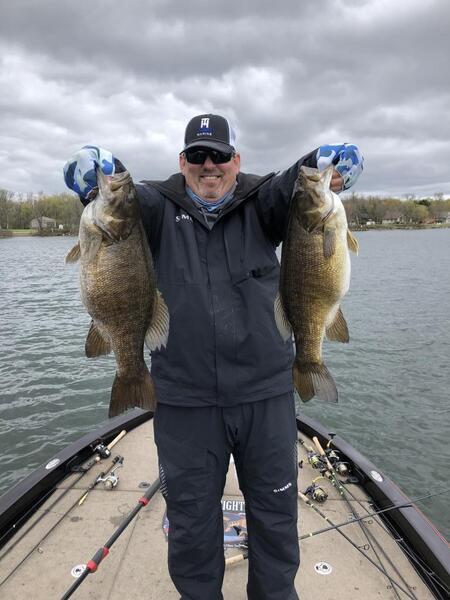
The biggest problem with carp, aside from the fact that icy winter conditions will block access to catching them, is that their gallbladders are poisonous. Carp bile is the only dangerous type of bile Clan cats encounter (that I know about so far). When being eaten, Clan cats must take care to gut them gently and remove the organ without spilling toxic green slime everywhere.
(ShadowClan actually collects and uses this bile for other purposes. Dried and diluted, it can be used as a medicine for treating parasites, and wet and mixed into a poultice it can be used to dress wounds. If gargled, it can also dissolve and loosen stuck bones in the throat, VERY important for unknowing kittens who tried to eat cooked bird bones.)
These two are the most common animals in the highly varied ShadowClan diet. Hunt in the shallow marsh, and you're bound to bump into either a duck or a carp at some point.
But when winter rolls in, they start to rely on mammalian prey.
3: Rats
While some rats can breach 2 pounds (SHOUT OUT TO ALL MY NEW YORKERS) most of them only clock in at about half a pound-- 250 grams. That's 1,250 calories. About 3 cats fed.
(NOTE: These estimations of how MANY cats they feed assumes that these bites are being distributed evenly, such as if the animal was being put into a soup or meticulously portioned. It's more likely that a single rat is eaten alone or only shared between two warriors who then bulk up. The sensation of "fullness" is determined by weight rather than caloric value.)
Rats are highly adaptable omnivores, but most of their diet is actually plants! Humans associate them with garbage and filth, and yes, the rats from carrionplace would certainly taste awful. But most of the rats ShadowClan catches would be living in natural conditions, eating nuts, fruits, and smaller animals. So it doesn't make sense that canon sees ALL rats as dirty-- they should actually be a HUGE part of a warrior's diet!
Especially in ShadowClan, where the invasive brown rat has all but eliminated the native black rat population. Brown rats are huge, thick-tailed, excellent swimmers who stick around in the winter and find themselves right at home in a marsh or swamp.
In fact, ShadowClan thinks hunting them is a two-way blessing. A cat stays fed through the winter, and more resources are freed up for the rarer, but more delicious water vole. ThunderClan isn't the only Clan that understands population management.
And speaking of...
4: Squirrels
Significantly smaller than carp and ducks, gray squirrels are usually about 500 grams. I've heard it said that they triple in mass over the winter, but since I'm not sure if that means they triple in weight, I'll simply rule that a wintertime gray squirrel is 1000 grams. Which means about 5,000 calories, enough to feed 14 cats.
...but also. don't underestimate how big a squirrel is. You are a 200-pound bipedal ape, these are 10 pound cats. They are also eating all the organs you, a human, would usually toss.

The general term, wetland, refers to all land that is... take a guess... wet. The difference between a marsh and a swamp is that a swamp is wooded land, which means squirrels can live there!
ShadowClan often finds itself in conflict with ThunderClan over squirrels. The native, endangered red squirrel is a cultural icon to ThunderClan and they believe it's important to protect it at all costs by killing gray squirrels whenever possible. ShadowClan, meanwhile, agrees red squirrels are beautiful, but isn't willing to be aggressive with gray squirrel populations to protect them.
5: Cheating
In true ShadowClan fashion I do what I want and use number 5 to babble about several animals they turn into grub
And SPEAKING of grubs, they love to forage for larval treats. They regularly make snacks out of chafer grubs, stag beetle larvae, cutworms, and if they can manage it, baby honeybees. Chafer grubs are their absolute favorite, which is another reason why WindClan is so passionate about maintaining their moorland; when it turns into grassland, ShadowClan is energized to fight for grub foraging space.
The "problem" with the meat of predators is that it's said to be tough and taste strong and unpalatable. ShadowClan doesn't entirely mind it, but if they end up with a predator in spring and summer, they like to use the seasonal stream (called a syke) that cuts across ThunderClan to soak the meat in running water for a few days.
Not to mention that they really will just grab at any animal, in addition to those lizards and frogs they're notorious for. Hedgehogs, crayfish, waterbirds, snails. There's all sorts of spices they'll use to try to season a strange meat, between mushrooms, pellitory, juniper, rosemary, so on.
It's harder to find something they WON'T eat.
136 notes
·
View notes
Text

Happy Froggy Friday with Toadlets!
The European common toad (Bufo bufo) in two variations with bonus toadlets! SciArt from Getreue Abbildungen Naturhistorischer, Bd. 1 (1793), edited by Johann Matthäus Bechstein.
But it's a toad! How can it be part of Froggy Friday?! All toads are frogs, but not all frogs are toads. Learn more about the differences, or should I say similarities.
View more in Biodiversity Heritage Library with thanks to Smithsonian Libraries and Archives for digitizing.
#frogs#toads#toadlets#herpetology#amphibians#froggy friday#frog friday#HistSciArt#Biodiversity Heritage Library#smithsonian libraries
359 notes
·
View notes
Text
Amphibiuary Day 16: Giant

A depiction of the reason frogs don't come into my garden much anymore...! My little dog Kala thinks she's making friends and is unaware that she's kind of a scary monster to the terrified, even smaller frogs (she did in fact lick one once but as you can imagine she learnt quite quickly never to do it again cjsnd)
#Amphibiuary2023#frogs#dogs#promarkers#artists on tumblr#my art#cockapoo#european common frog#giant#traditional art#cartoon#illustration#traditional illustration#cartoon illustration#cute#Amphibiuary#original work
82 notes
·
View notes
Text
I have tried to choose a wide distribution of animals representing many different clades, aiming for relatively intelligent species within their respective clade. There are only 12 poll options possible, so no asking “what about X?” Inevitably some species will have to stand in for a much broader class than others, e.g., the Humboldt squid for all cephalopods. (But the Humboldt squid is probably a good choice: they’re fairly gregarious and cooperative, unlike the octopus.)
Uplifted species will have the capacity for language, abstract thought, tool use, episodic memory, planning, and self-awareness. Their cognition may in other respects be radically different from our own, especially if they are not mammals.
67 notes
·
View notes
Text
I wanted to use my frogposting today to talk about the frogs and toads of palestine!

bufotes viridis, the european green toad, can be found across gaza and the west bank (and also a bunch of europe and north africa!) [📷 peter kaufman]

hyla savignyi, the levantine tree frog, can also be found throughout palestine and is very small (only about 4cm long!) [📷 zeynel cebici]
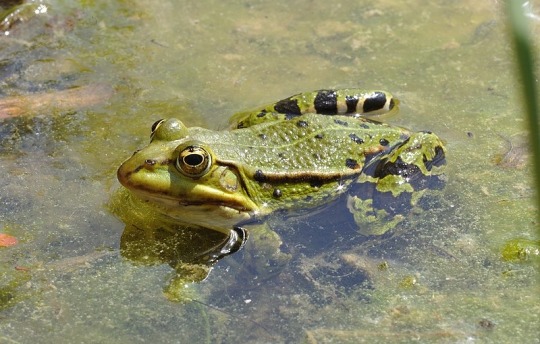
rana ridibunda, the marsh frog, which is also the largest frog in europe! a real frog’s frog [📷 quartl]
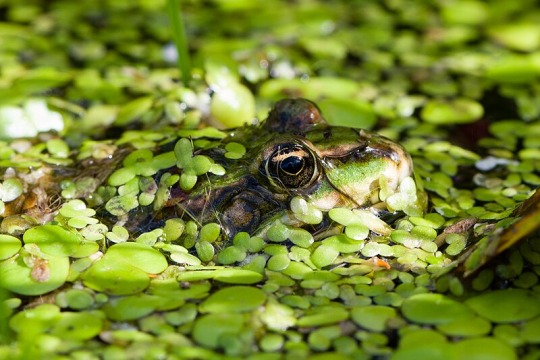
pelophylax esculentus, the pool frog (pictured here very much In The Soup Or Perhaps Spinch), this is the one that they make frog legs with and is found in the dead sea and galilee [📷 tuxyso]

pelobates syriacus, the eastern spadefoot toad, is a threatened species in palestine but is common in places like turkiye and iran [📷 f.c. robiller]
[references: Dr. Sc. Norman Ali Bassam Ali Taher Khalaf-Sakerfalke von Jaffa, “Amphibia Palaestina : The Amphibians of Palestine.” Gazelle vol. 84, 2008]
80 notes
·
View notes
Text

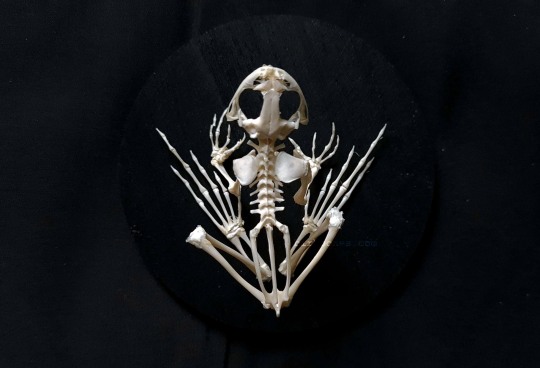


A few skeletons I recently articulated :) Juvenile Pygmy Goat, European Common Frog & Female Meerkat
#vulture culture#taxidermy#animal skull#vulture culture uk#bones#my collection#skulls#oddities#animal skulls#dead things#skeletons#animal skeleton#skeletal articulation
153 notes
·
View notes
Text

A breeding group of European common frogs
By: F. Greenaway
From: The Complete Encyclopedia of the Animal World
1980
#mating cw#common frog#frog#amphibian#1980#1980s#F. Greenaway#The Complete Encyclopedia of the Animal World (1980)
162 notes
·
View notes
Text
Flower Moon - May 5, 2023
Ready your gathering baskets and your best shoes for traipsing, witches - it's time to greet the Flower Moon!
Flower Moon
The Flower Moon gives us the fulfillment of the first flush of the Pink Moon, with fragrant blossoms greeting us at every turn and heralding the merry month of May. The floral name for this particular cycle is shared by a number of indigenous nations, include the Algonquin, Anishnaabe, and Dakota. Other names include Budding Moon and Frog Moon (Cree), Planting Moon (Dakota and Lakota), and the Moon of Mulberry (Choctaw).
European names for this moon include Milk Moon (Anglo-Saxon) and Hare Moon (Celtic, allegedly). Modern pagan circles sometimes call it the Grass Moon as well, since the flourishing of grasslands is more common in some areas than the appearance of flowers.
Notes: This year, there is a Penumbral Lunar Eclipse accompanying the Flower Moon. This is a barely visible shadow on the full moon which will be visible largely in the Eastern Hemisphere. Check your local astronomical forecast to see if it will be visible in your area.
This full moon peaks during daylight hours in the Western Hemisphere (around 1:35pm EDT), so the moon may appear to be full on both the nights of the 4th and 5th. It also falls about three-quarters through a Mercury Retrograde, so take whatever steps you deem appropriate.
What Does It Mean For Witches?
As we pass the spring rites and move toward the summer season, it's the perfect time to celebrate your growth and the ways in which you want to flourish. This is the season for romance and love, and not just that which comes when we put on flower crowns and go a-Maying. This is a time to love ourselves as much as each other, and to be reminded of our own beauty and strength. Remember the things you love about yourself and consciously take a moment to remind your loved ones how much you care for them.
It is also a time to celebrate fertility, be it animal, vegetable, mineral, or spiritual. Put new plans into action, start that project you've been meaning to do, embark on that new hobby or activity you wanted to try. If you have a long-term goal or a big project, now is the time to outline your path to completion and plan how to direct your energy so you don't burn out halfway through. Don't hold back - break through the walls of imposter syndrome and anxiety, indulge in your creative urges, and let your inspiration soar. What you choose to plant and nurture now determines what you will harvest later in the year. And above all, remember to have FUN!
What Witchy Things Can We Do?
If you've been feeling the urge to do some flower-related magic, now is the perfect time! Familiarize yourself with the wildflowers in your area and if possible, maybe grab your basket and scissors and go on a foraging trip. Remember to properly identify flowers before picking them, don't overharvest, and don't take anything from private property without permission or from national parks full stop. You can press the flowers with a notebook and something flat and heavy, or you can dry them in hanging bunches, in a cardboard tray, or in a low-temp oven for later use.
This is also a good opportunity to get your hands in the dirt and connect with the land where you live. If there are plants in your care, take a little time to do some pruning and watering. Check them for spring pests and treat where needed. Give them some love - talk to them, sing to them, encourage them to grow tall and strong and abundant. Bless them as you tend their plots and reaffirm your commitment to be a good caretaker.
As an exercise, try making flower crowns, garlands, bouquets, wreaths, or centerpieces using plant correspondences, flower language, or color magic for a desired effect. This can be done with real flowers or silk ones, depending on how long you want to keep them around. Try your hand at making flower water with roses or other blooms - it makes a wonderful base for moon water!
Experiment with recipes for dishes and drinks that use edible flowers too! Whether it's color-changing butterfly peaflower tea, sweet and peppery nasturtium, adorable pressed pansy shortbread cookies, or the tried-and-true comforts of chamomile, flowers have many tasty secrets to offer. Don't be afraid to add botanicals to your health and beauty routine as well! (Just make sure nothing's going to negatively interact with your meds or irritate a pre-existing condition. Safety first!)
Whether you do so with your near-and-dear, your witchy circle, or by yourself, celebrate everything that blooms - including you!
Happy Flower Moon, witches! 🌕🌼
Further Reading:
Flower Moon: Full Moon in May 2023, The Old Farmer's Almanac
Moonrise and Moonset Calculator, The Old Farmer's Almanac
Flower Meanings: Symbolism of Flowers, Herbs, and More Plants, The Old Farmer's Almanac
Floriography, the Language of Flowers, AllFlorists.co.uk
Flower Moon: The Astonishing Full Moon of May 2023, The Peculiar Brunette
How to Dry Flowers 5 Ways, MasterClass, June 7, 2021
DIY Floral Water or Hydrosol, Patti Estep, Hearth and Vine, July 4, 2021
17 Edible Flower Recipes, Better Homes and Gardens, March 8, 2022
Everyday Moon Magic: Spells & Rituals for Abundant Living, Dorothy Morrison
(If you're enjoying my content, please feel free to drop a little something in the tip jar or check out my published works on Amazon or in the Willow Wings Witch Shop. 😊)
#Flower Moon#witchblr#lunar magic#moon magic#witchcraft#lunar calendar#pagan#secular witchcraft#flower magic#green witchcraft
267 notes
·
View notes